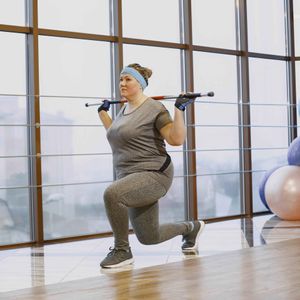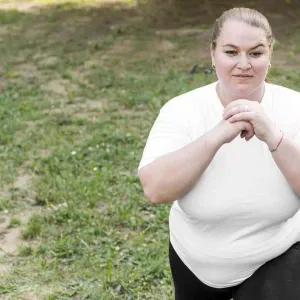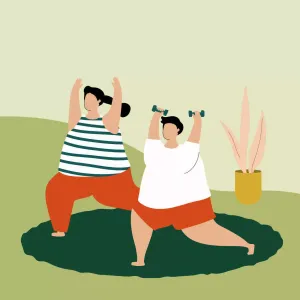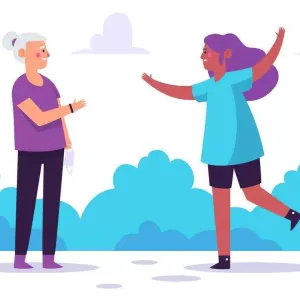

Our Review Process
Our articles undergo extensive medical review by board-certified practitioners to confirm that all factual inferences with respect to medical conditions, symptoms, treatments, and protocols are legitimate, canonical, and adhere to current guidelines and the latest discoveries. Read more.
Our Editorial Team
Shifa Fatima, MSc.
Author
Dr. Apoorva T, MHM.
MEDICAL ADVISOR
Why Strengthen Your Core
When you think of someone with a strong core, you likely think of someone doing a lot of crunches to enhance their muscles. However, gaining abdominal strength has benefits that go well beyond aesthetics, as it could make daily activities easier for you and enhance your general well-being. Your core is more than just the muscles in your front body that give you a "six-pack." Instead, it completely encircles your body, encompassing the muscles in your back and sides. Therefore, having stronger core muscles overall, especially the inner core muscles that link to your spine can assist you to maintain better health. Furthermore, the better posture that comes with a strong core can help you avoid some of the irritating neck and back ache that comes with hunching over your laptop all day. Listed below are three reasons why it is important for you to strengthen your core strength.
1. Your Core Is Your Entire Support System
Your core muscles play a significant part in many of your daily actions, like getting out of bed, strolling down the street, and stooping to pick up your pocketbook. However, they serve one extremely vital purpose beyond all others: they literally keep you upright. One muscle does not make up your abs. Your transverse abdominis, which supports your spine and pelvis, is the inner core of abdominal muscles and possibly the most crucial. Then there are two layers of oblique muscles that regulate spinal motions like lateral flexion and rotation. The rectus abdominis, the uppermost muscle and the one that gives you a six-pack, runs vertically across the front of your abdomen. Whether you're active or just sitting at your computer, a strong core helps you maintain a more upright and erect posture. Consider your body as a tree trunk that must maintain its ground for your branches, or your arms and legs, to perform their duties. And working on your core over time can help with posture, thereby helping your tree trunk work better.
2. A Healthy Core Makes Everyday Life Easier
All of your movements start at your core. Therefore, the more stable you are in your core, the simpler it is to carry out daily tasks like stooping down to pick something up off the floor, standing for extended periods of time, or performing household duties. Due to the fact that they can significantly increase your functional capacity, many abdominal exercises fall under the category of functional fitness. They can make your daily activities easier and help you work more effectively.
3. It Helps To Reduce Or Prevent Pain
Even though getting out and moving may be the last thing on your mind when you're suffering from chronic pain, several studies have shown how beneficial core strength training is for back and hip discomfort. Compared to resistance exercises, core strengthening is a safer and more manageable kind of exercise for persons with back discomfort. It also eases any discomfort you may be experiencing, reinforces your lower back, strengthens your spine, and ultimately improves your state of mind. This is due to the fact that having a strong core has knock-on consequences that may help you prevent irritation and decrease the discomfort from actions like spending all day at a computer. These benefits include better posture, greater balance, and the ability to move about more easily.
Table of Contents
Abdominal Exercises for Seniors: The Big 7
Now that we are aware of how crucial it is to strengthen your core, let's examine some of the best exercises you can do to do so, which would also improve your health. To start, select three or four of these exercises and practice them around three times each week. Before beginning any new workout regimen, it's often a smart option to consult with a doctor, especially if you have any underlying medical conditions like osteopenia, osteoporosis, or high blood pressure.
1. Abdominal Bracing
The easiest approach to building your core anywhere, anytime is to brace your abdominals. Making it a routine may have a strong strengthening impact on your core and potentially improve your posture, regardless of the fact that it may appear overly simple at first. All healthy, active people instinctively brace themselves throughout all types of movement. Our bodies utilize this instinctive reaction to protect our spines from harm. It is crucial to safeguard your spine from postures that might harm your spinal cord, vertebrae, or nerves because your nervous system—specifically, your spinal cord and the nerves that branch from it—travels through your vertebrae. With practice and persistence, abdominal bracing may indeed be mastered. The ultimate objective is to develop abdominal bracing ability to subconsciously induce intra-abdominal pressure.
How to do:
- Stand tall to start.
- Next softly clench your abs while drawing in your belly button toward your spine.
- Practice this contraction several times a day, holding it for as long as it feels comfortable.
- Don't forget to breathe!
Benefits:
- Carry out daily activities and motions more effectively.
- Optimize your running gait and form.
- Effectively activate the abdominal muscles.
Precautions:
- Make sure that you are breathing regularly throughout the exercise.
- Remember to take it slowly, especially when you are a beginner.
2. Pelvic Lifts and Tilts
Exercises called pelvic tilts, which include incredibly subtle spinal movements, are used to tone the abdominal muscles that support the low back. They are an excellent opening exercise for anyone looking for relief from low back pain. Exercises involving pelvic tilt engage the intrinsic core stabilizers, which helps the low back to labor less when the core is engaged. The Basic Pelvic Tilt is an isometric hold to activate the intrinsic core stabilizers.
How to do:
- With your knees bent, lie on the ground.
- Hold the position for up to 10 seconds while slowly raising your pelvis and bending your lower back into the floor.
- You should try to perform these pelvic exercises between 10 and 20 times each session on a regular basis to see improvements.
Benefits:
- Correct the alignment of the lumbar spine.
- Relief from chronic lower back pain.
- Stronger core muscles
Precautions:
- While concentrating, don't forget to breathe.
- Correctly engage your core
- Be careful not to elevate your pelvis.
3. Chair Planks
The deep core muscles may be strengthened by performing planks. One of the finest bodyweight workouts is the plank-to-chair squat since it targets many muscle groups simultaneously. It efficiently tones the legs, glutes, and core and uses only your body weight as the sole additional equipment. Learning how to execute a plank-to-chair squat can provide you with a simple technique to engage your entire body wherever you are.
How to do:
- Place a chair so that the seat is facing you.
- Position your hands on the seat of the chair while standing facing it. They ought to be located close to the front legs' corners of the chair.
- Walk your feet back until you are in a straight line from your hips to your feet.
- Keep your head up and unlock your elbows. Your shoulders should be aligned with your hands. Put your heels closer together.
- Hold this posture as long as you can while focusing on how it feels to pull your belly button up and toward your spine. Increase the number of repetitions to three to five.
Benefits:
- Strengthen the entire body.
- Improve your posture.
- Reduce low back pain.
- Enhance your balance.
- Increased flexibility.
Precautions:
- Avoid arching your back.
- Do not let your hips sag.
- Keep your head from tilting up.
4. Wood Chops
The core is worked with many workouts, but very few engage it as strongly as the wood chop. This exercise maintains the rotational movement pattern of your trunk, as well as several back and abdominal muscles for stability. Your arms and legs also contribute to stability and movement. Most significantly, it is employed in rehabilitation to treat and control lower back discomfort. It presents a tougher challenge for core stability.
How to do:
- Spread your feet wider than your shoulders and clasp your hands together in front of you.
- Next, raise one of your arms above your head.
- Squat while maintaining a tight core and "chopping" your hands diagonally down toward the opposite side of your body.
- Go back up to the top and repeat.
Benefits:
- Increase the stability of several muscles in your shoulders, hips, and trunk.
- Enables effortless execution of daily tasks like lifting, pushing, and pulling.
Precautions:
- Throughout this movement, keep your trunk still.
- Starting with a lesser weight than you anticipate would be necessary to complete this exercise. As needed, increase the weight while exercising appropriate restraint.
- Reduce your range of motion and slow down your speed if you experience discomfort while doing this action.
5. Bridge
The bridge exercise improves core stability while strengthening your hamstrings and glutes. It's simple to incorporate into a strength training routine, can be used as a warm-up, and even works well for core and spinal stability during rehabilitation. The posterior chain, which is a crucial component of the core and encompasses the glutes, hips, low back, and abs, may be strengthened using bridge movements. This will enable you to move freely and pain-free by maintaining the spine's and disks' proper alignment.
How to do:
- Locate a flat area on the floor, and lie on your back.
- With your knees bent and your feet flat on the ground, rest your hands at your sides.
- By pressing your low back into the ground, tighten your abdominal and buttock muscles.
- Raise your hips to create a straight line from your knees to your shoulders.
- Pull your belly button back toward your spine while using your core muscles.
- Hold for 20 to 30 seconds.
- Lower the hips to return to the starting position.
Benefits:
- Increase flexibility.
- Relieve knee and back pain.
- Build up your core, particularly your abs.
- Trim your obliques as well as your waistline.
- Boost your equilibrium.
- Improve your posture.
Precautions:
- Avoid raising your hips excessively.
- Keep your hips from sagging.
- When you first begin, hold the bridge posture for no more than a few seconds at a time until your strength increases.
6. Superman
For people of all fitness levels, the superman exercise is a useful and effective workout. It targets your abs, glutes, hamstrings, and lower back muscles. Additionally, it supports other core workouts like leg raises and sit ups that primarily target the front abdominal muscles of your body.
How to do:
- Lay face down on the floor with your arms out in front of you and your legs straight.
- Lift your arms and legs gradually off the floor until you feel your lower back muscles tense, keeping your head in a neutral posture. While you're doing this, contract the muscles between your shoulder blades, your core, and your glutes.
- Focus on lifting your belly button slightly off the floor to contract your abs. Imagine yourself flying through the air as Superman to help you visualize this.
- Hold this posture for two to three seconds. Make sure you are breathing throughout.
- Return to the floor by lowering your arms, legs, and belly. Do 2-3 sets of 8–12 repetitions of this exercise.
Benefits:
- Strengthen the erector spinae muscles.
- Prevent postural deviations.
- Stronger legs and buttocks.
Precautions:
- Make sure to raise your limbs gradually and hold the pose for at least two to three seconds before descending.
- Try not to overextend your lower back.
- Avoid pointing your toes, despite the temptation.
- Be careful not to overextend your arms and legs.
- Exercising on a soft surface is preferable.
7. Deadbug
The dead bug exercise is a well-liked exercise for developing stability and core strength. Moving heavy items, walking up hills, and throwing are all made easier and more comfortable as a result of helping to create a strong, sturdy foundation that safeguards the spine. By supporting your lower back, this movement also aids in the prevention and treatment of low back discomfort. Because it appears as though your arm and leg are thrashing about and nothing is happening, you won't see many individuals executing the dead bug on social media. The dead bug, however, is arguably the ideal core stability exercise. This, however, could not be further from the truth.
How to do:
- Lift your feet off the ground as you lie on your back. With your toes pointed up, bend your knees 90 degrees.
- Your hands should be precisely above your shoulders as you raise your arms toward the ceiling. You now resemble a dead bug.
- Perform a posterior pelvic tilt to flatten your lower back.
- Take a deep breath through your nostrils and feel your entire body expand.
- Breathe out with your back firmly planted on the ground while extending your left arm behind you and your right leg in front of you at the same moment.
Benefits:
- Strengthen and stabilize your core, spine, and back muscles.
- Improve balance and coordination.
Precautions:
- Throughout the workout, keep your hips and low back still.
- Make sure to move carefully, gently, and with good posture.
- Keep your abdominal muscles tightened throughout the exercise.
FAQ
1. What exercise burns the most belly fat for seniors?
- Abdominal Bracing
- Pelvic Lifts and Tilts
- Chair Planks
- Wood Chops
- Bridge
- Superman
- Deadbug
2. How can I tighten my stomach at age 65?
- Abdominal Bracing
- Pelvic Lifts and Tilts
- Chair Planks
- Wood Chops
- Bridge
- Superman
- Deadbug
3. How can I flatten my 70-year-old's stomach?
- Abdominal Bracing
- Pelvic Lifts and Tilts
- Chair Planks
- Wood Chops
- Bridge
- Superman
- Deadbug
4. What are the 5 foods that burn belly fat after 65?
It is important to note that there is no single food that can target belly fat specifically. However, incorporating certain foods into a healthy diet can help promote weight loss and overall health. Here are 5 foods that can support weight loss efforts, including belly fat, for individuals over the age of 65:
1. Leafy greens:
Leafy greens such as spinach, kale, and collard greens are packed with fiber, vitamins, and minerals, and are low in calories. They can help fill you up without adding a lot of calories to your diet.
2. Berries:
Berries such as strawberries, blueberries, and raspberries are low in calories and high in fiber, making them a great addition to a weight loss diet. They are also packed with antioxidants that can help protect against inflammation and age-related diseases.
3. Lean protein:
Incorporating lean protein sources such as chicken, fish, and tofu can help build muscle mass and increase metabolism, which can help promote weight loss and fat burning.
4. Whole grains:
Whole grains such as brown rice, quinoa, and whole wheat bread are high in fiber and can help keep you feeling full and satisfied for longer periods of time, which can help reduce overall calorie intake.
5. Nuts and seeds:
Nuts and seeds such as almonds, walnuts, and chia seeds are rich in healthy fats and protein, which can help keep you feeling full and satisfied. They can also help regulate blood sugar levels, which can help reduce cravings and promote weight loss.

Disclaimer
This website's content is provided only for educational reasons and is not meant to be a replacement for professional medical advice. Due to individual differences, the reader should contact their physician to decide whether the material is applicable to their case.








